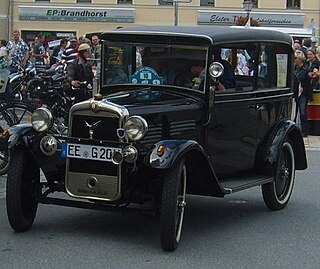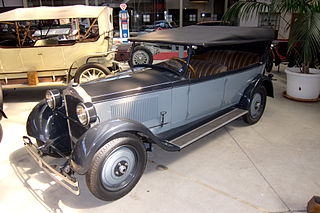
Stoewer was a German automobile manufacturer before World War II whose headquarters were in Stettin.

The Opel Kadett is a small family car produced by the German automobile manufacturer Opel from 1936 until 1940 and then from 1962 until 1991, when it was succeeded by the Opel Astra.

Crosley was a small, independent American manufacturer of economy cars or subcompact cars, bordering on microcars. At first called the Crosley Corporation and later Crosley Motors Incorporated, the Cincinnati, Ohio, firm was active from 1939 to 1952, interrupted by World War II production. Their station wagons were the most popular model, but also offered were sedans, pickups, convertibles, a sports car, and even a tiny jeep-like vehicle. For export, the cars were badged Crosmobile.

The Chrysler Imperial, introduced in 1926, was Chrysler's top-of-the-line vehicle for much of its history. Models were produced under the Chrysler name until 1954, after which Imperial became a standalone make; and again from 1990–93. The company positioned the cars as a prestige marque to rival Cadillac, Continental, Lincoln, Duesenberg, Pierce Arrow, Cord, and Packard. According to Antique Automobile, "The adjective 'imperial' according to Webster's Dictionary means sovereign, supreme, superior or of unusual size or excellence. The word imperial thus justly befits Chrysler's highest priced model."
The BMW 3/15 was BMW's first car, produced in its first version as a "Dixi" between 1927 and 1929 and then, following BMW's acquisition of the Dixi business in October 1928, in three subsequent versions as BMWs from July 1929 till March 1932, when BMW gave up the licence under which the Austin designed cars were produced.

The Opel Olympia is a compact car by German automaker Opel, then part of G.M., from 1935 to 1940, and after World War II continued from 1947 to 1953. It was one of the world's first mass-produced cars with a unitary body structure, after the 1934 Citroën Traction Avant; and it was a mass-production success, made in six-figure numbers. Opel achieved this even before the war, all while Hitler promised Germany a "Volkswagen" - a 'People's car', which didn't materialize until 1946. From 1967 to 1970 the Olympia badge was briefly reused on a later car.

The Mercedes-Benz W136 was Mercedes-Benz's main line of inline-four cylinder motorcars from the mid-1930s into the 1950s. The model 170 V made its public debut as successor to the W15 Typ 170 in February 1936. Between 1936 and 1939 it was Mercedes' top selling model.

The BMW 303 was a small family saloon produced by BMW in 1933 and 1934. It was the first BMW motor car with a six-cylinder engine and the first BMW motor car with the "kidney grille" associated with the brand. The platform developed for the 303 was used for several other BMW cars, including the BMW 309, a four-cylinder version of the 303, the BMW 315, a 1.5-litre version of the 303 which replaced it in 1934 and was built until 1937, the BMW 319, a 1.9-litre version of the 303 produced alongside the 315 from 1935 to 1937, and the BMW 329, a development of the 319 with styling based on the newer, larger BMW 326, that briefly replaced the 319 in 1937.

The Ford Model 48 was an update on Ford's V8-powered Model 40A, the company's main product. Introduced in 1935, the Model 48 was given a cosmetic refresh annually, begetting the 1937 Ford before being thoroughly redesigned for 1941. The 1935 Ford's combination of price, practicality, and looks vaulted the company ahead of rival Chevrolet for the sales crown that year, with 820,000 sold.

The Mercedes-Benz 500K (W29) is a grand touring car built by Mercedes-Benz between 1934 and 1936. First exhibited at the 1934 Berlin Motor Show, it carried the factory designation W29. Distinguished from the 500 sedan by the "K" for Kompressor, only fitted to these performance cars, it succeeded the Mercedes-Benz 380 introduced just the previous year. It offered both a larger, more powerful engine and more opulent coachwork to meet customers' demands for greater luxury and performance.

The Mercedes-Benz 540K (W29) is a grand touring car built by the German firm Mercedes-Benz between 1936 and 1940.

The Steyr 120 Super, Steyr 125 Super and Steyr 220 were a series of medium-sized cars built by the Austrian firm Steyr-Daimler-Puch from 1935 to 1941. The moderately streamlined body was designed by technical director Karl Jenschke (1899-1969) and was manufactured by Gläser-Karosserie GmbH in Dresden. The design had a close resemblance to the smaller Steyr 100.
The Brennabor Typ S, launched in 1922, was a car introduced by the Brennabor company in order to complement their larger Typ P model. In 1925 it was replaced by the Brennabor Typ R which was essentially an updated version of the same model.
The Brennabor Typ B “Juwel 6” is a six-cylinder automobile introduced by the Brennabor company in 1929 as a successor to the des Brennabor Typ A.

The 1 Litre Brennabor Typ C is a small car introduced by Brennabor in 1931. In the wake of a sustained period of economic difficulties it represented a belated extension of the company’s range into the "small car" sector which hitherto Brennabor had ignored. In 1933 the car was upgraded and became the short-lived Brennabor Typ D

The Ford Taunus G93A is a small family car that was produced by Ford Germany between 1939 and 1942 in succession to the Ford Eifel. It was the first car developed at Cologne by Ford Germany which previously had built cars originated by Ford businesses in the US or the UK. Production began on 30 April 1939, with the first car exhibited to the public in June 1939, less than six months before the outbreak of war in Europe.

The Opel 7/34 PS is a large but relatively inexpensive six-cylinder-powered car manufactured by Opel, introduced in October 1927. It was replaced in 1928 by the Opel 8/40 PS which was virtually identical except that the cylinder capacity had been increased. Significant changes to the chassis took place in February 1929, after which production of the model continued till September 1930. The 8/40 PS was replaced by the Opel 1.8 Liter in 1931, also a compact six-cylinder car.

The Mercedes-Benz W 142 was a six-cylinder passenger car launched in February 1937, as a successor to the Mercedes-Benz Typ 290. The car was known by its name Typ 320 at the time of its production and service, but is in retrospect commonly referred to using its Mercedes-Benz works number, "W142", which gives a more unambiguous, unique nomenclature.

The Chrysler Six was a series of cars that were all installed with the Chrysler Straight Six when the company assumed operations of the Maxwell Automobile Company in 1924, and Chalmers Automobile Company in 1926. The Chrysler Six initially consisted of several Models, then Series designations that originally declared the approximate top speed each vehicle was able to consistently maintain, then each series number was incrementally updated every new model year, and each series was offered in several body style choices. The engines were technically advanced for their time and were entered in the 24 Hours of Le Mans for 1925, 1928 and 1929.

Stoewer Sedina is an executive car manufactured by Stoewer automotive company between 1937 and 1940. It has rear-wheel drive with 2.4-litre four-cylinder overhead valve engine and is available in sedan and convertible versions.
























